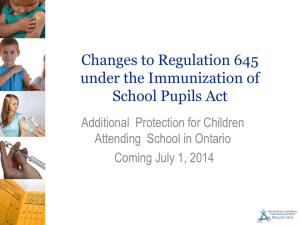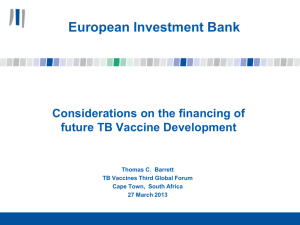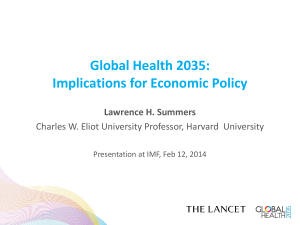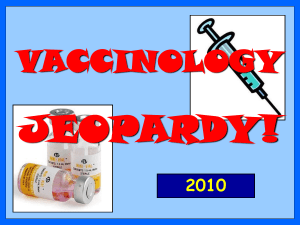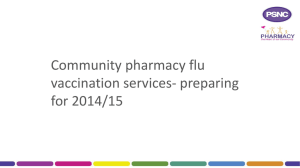Maternal Immunization: Tdap and Influenza
advertisement
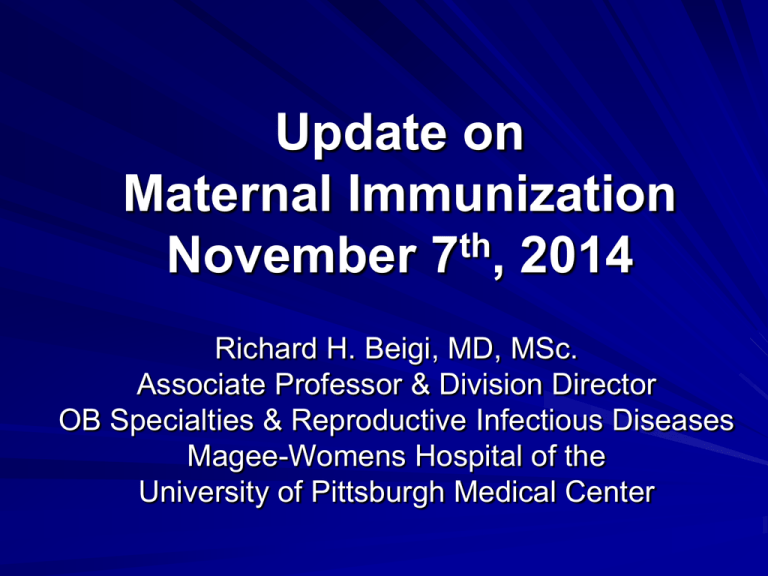
Update on Maternal Immunization November 7th, 2014 Richard H. Beigi, MD, MSc. Associate Professor & Division Director OB Specialties & Reproductive Infectious Diseases Magee-Womens Hospital of the University of Pittsburgh Medical Center Potential COI Research site: Novartis Vaccine and Diagnostics: GBS Maternal Immunization Study Novavax Inc. RSV Maternal Immunization Study Sit on: – NVAC MIWG, ACIP Pertussis WG Consultant to (& Contracts with): – NIH/NIAID, CDC, ACOG, AHRQ, BARDA Immunization Advocacy for pregnant women Outline Brief Background on Immunization Maternal Immunization Influenza Tdap Ongoing policy/research considerations Summary History Jenner 1796 – 1st attempt to control ID through deliberate inoculation – Milkmaids –> cowpox…immune to smallpox – Inoculated susceptible persons…no smallpox 2nd to sanitation & H20 safety Overall disease prevention 10 major ID’s controlled extensively – Smallpox gone – Other VPD’s nearly gone Courtesy: SA Plotkin:2006 Immunization Defined: – Immunity artificially induced &/or provided Active vs. Passive – Active: Induce body to produce lasting defenses against infection – Vaccines – Ab (IgG) Influenza, Hep A/B, HPV, etc. – Passive: Temporary protection given by exogenously produced/pooled Ab VZIG, HBIG, Placental transfer, etc. Active Immunization highly effective – Most vaccines > 80-90% effective Conceptual Basis Courtesy: SA Plotkin:2006 Conceptual Basis Courtesy: SA Plotkin:2006 Vaccine Safety Numerous concerns raised – GBS, Thimerosol & Autism (multi-dose vials), Anaphylaxis….. – Storage concerns IOM Reports – Insufficient evidence to prove causation for most vaccine-related problems 1986 – National Childhood Vaccine Injury Act National Vaccine Injury Compensation Program – VICP 1990 Vaccine Adverse Events Reporting System – VAERS – 1990 (CDC+FDA) Pregnancy No direct evidence: – Risk to fetus with any vaccine – Theoretical risk – R vs. B But… – Most live vaccine viruses ? Viremia SAB risk greatest 1st tri – Avoid live virus vaccines MMR, Varicella, LAIV, Polio – Avoided 1st tri vaccination/IG Not evidenced based Maternal immunization for newborn benefit – 1st 6 months of life Pregnancy Unique Time Pregnant women motivated to improve health Pregnancy motivates some to quit smoking Curry. Psych of Add Behav 2001;15(2) Frequent HC interactions: PNC Motivated to optimize fetus/neonatal outcomes Often preferentially over themselves Provider input key! Maternal Immunization Success Neonatal Tetanus Substantial progress 145% of total neonatal death (‘93-’03) 82 57 countries “not eliminated” Maternal Immunization key WHO: Td during pregnancy Rh Alloimmunization [Rho(D)] – 1970’s Previous 9-10% total pregnancies affected Now rare in Rh- women (<1% Rh- pregs) Rubella post-partum immunization (CRS) Vandelaer J. Vaccine 2003;21 http://www.who.int/immunization_monitoring/diseases/MNTE_initiative/en/index2.html ACOG Practice Bulletin #4: Prevention of RhD Alloimunization Summary 2009 H1N1 & Pregnancy Validated higher morbidity in pregnancy Hospitalization, Critical Care needs PTL/PTB Validated higher mortality (5-13 fold) Validated: – Importance of influenza vaccine in pregnancy Influenza Immunization Most promise for Influenza prevention – Immunization – + VE in pregnancy (@ 65% = general population) TIV recommended: USA: Surgeon General 1960, 1990s : during 2nd and 3rd trimester – 2004 & ACOG: changed to any trimester, Essential PNC Element 2005 WHO CDC 2010: All persons > 6 mos. age All pregnant women in any trimester ACOG: Essential part of PNC (2004) – New ACOG CO out September 2014 Stronger case for: – Ob Provider Recommendation – Safety data – Neonatal Benefit Thompson MG. CID 2014:58 ACOG CO #608:2014 Influenza vaccination rates during pregnancy, Canada and United States, 1974-2003 Authors, year (reference) Population Study Period Source of Vaccine Data Vaccination Rate (%) Neuzil et al., 1998 (11) Medicaid population, United States 1974-1993 Medicaid database <0.1 Mullooly et al., 1986 (10) Managed care organization, United States 1975-1979 Medical record review <1* Black et al., 2004 (18) Managed care organization, United States 1997-2002 Vaccine Registry 7.5 Munoz et al., 2005 (19) Clinic population, United States 1998-2003 Clinic Database 3.5 Silverman & Greif, 2001 (35) Hospital-based survey of postpartum women, United States 2000 Self-report 8 Tuyishime et al., 2003 (44) Hospital-based survey of postpartum women, Canada 2002 Self-report 2 NHIS,+ 2003 (34) Population-based telephone survey, United States 2003 Self-report 12.8 *Vaccination +NHIS, rate was 6% during the 1976 swine flu vaccination campaign National Health Interview Survey Naleway AL. Epidemiol Rev 2006; 28 Influenza Vaccine in Pregnancy Ob-Gyn national: 13% get vaccine (CDC-MMWR;2005(54)) – Yeager, et. al., Am J Perinatol 1999;16:283-6 * 71% were offered influenza vaccine accepted vaccination* Prior to 2009 – Nationally @ 15% pregnant women – 2009 H1N1 @ 50% – Sustained @ 50% since Healthy People 2020 Goal: 80% CDC. MMWR 2010;59. ACOG. Obstet Gynecol 2004;104 CDC. MMWR 2011;60. Ding H. AJOG 2011;204. CDC. MMWR 2010;59. D. Internet Panel Survey, 11-2013. www.cdc.gov Influenza Vaccine Safety IT IS SAFE – Collaborative Perinatal Project 1957-66 NIH-sponsored longitudinal study > 50,000 pregnant women immunized offspring followed for 7 years and assessed for congenital malformations, learning problems, hearing loss, and cancer – 2,291 doses TIV given – No significant increase in adverse reactions in mothers or infants – 252 pregnant women who received TIV within 6 months of delivery matched with 826 unvaccinated pregnant women No difference in pregnancy outcomes – Estimated 2 million pregnant women vaccinated in 2000-03 No unexpected adverse events reported to VAERS. Three miscarriages reported, not known to be causally related to vaccination – > 15-20 investigations – SAFE!! Heinonen. Int J Epidemiol 1973;2:229-35 Munoz Am J Obstet Gynecol 2005;192:1098-1106 Pool V. Am J Obstet Gynecol 2006;194:1200 Influenza Vaccine in Pregnancy Effectiveness and Immunogenicity – Effectiveness of vaccine in pregnant women – Exclusion from clinical trials – Studies have not included specific outcomes such as laboratory-confirmed influenza ELISA Units Pregnant women given TIV develop protective concentrations of anti-influenza antibodies Maternal immunization increases the amount of antibody transmitted to infants Limitations: Antibody to influenza A and B in mothers and their infants following maternal immunization with TIV or TT (control) 18000 16000 14000 12000 10000 8000 6000 4000 2000 0 Control Control Control H1N1 H1N1 H3N2 B H3N2 B Mother delivery Infant delivery Infant 2 mo Englund et al: J Infect Dis 1993;168:647-56 Transplacentally-acquired influenza Antibody and Disease in Infants ▀ Correlation between level of cord blood antibody and age at time of influenza A/H3N2 infection, suggesting protective effect (26 infants), Puck, et. Al., J Infect Dis 1980;142:844-9 ▀ Infants of mothers with antibody to influenza A/H1 had delayed onset and decreased severity of influenza disease (39 mother-infant pairs), Reuman et al, PIDJ 1987;6:398-403 Mother’s GIFT Study RCT 340 moms 2004-05 Bangladesh ½ influenza vaccine, ½ pneumococcal vaccine 316 M-I pairs: - 63% flu VE for babies - 30% less ILI for babies - 36% less ILI for moms Conclusion: Maternal vaccination benefits: moms & babies < 6 mos old *NNT: 5 maternal vaccinations to prevent 1 case ILI in mom or infant *NNT: 16 maternal vaccinations to prevent 1 proven flu illness in infant Zaman et al. NEJM 2008;359 Summary of Benefits Flu Maternal Immunization NEJM 2014;371:918-31(Matflu) – South Africa – HIV + and HIV- pregnant moms: HIV (-) – 2116 pregnant women, trivalent flu vaccine, 2011-’12 – 2x-blinded, Placebo-RCT, Safety & efficacy: mom/baby- 24 wks after birth – PCR-confirmed influenza Higher titers in moms/babies vaccine (p< 0.001) VE: 48-50% (moms & babies) SAFE Summary of Benefits Influenza Vaccine Summary Influenza Vaccine: – Safe in pregnancy Cont’d validation with all ongoing research – Effective (mom and baby) Out to 6 months for neonate – ? Fetal benefits – * Strongly CE (cost-saving) All pregnant women to receive – Ob Provider Recc Key! *Beigi et al. CID 2009;49 Tdap Tetanus, Diptheria, Pertussis 2 Toxoids and acellular pertussis – Pertussis key 2 Tdap Vaccines since 2005: – ADACEL (Sanofi) – licensed for ages 11-64 – BOOSTRIX (GSK) – licensed for ages 10-18 – Both licensed for: Single-dose use to add protection against Pertussis and to replace the next booster dose of Td Poorly control VPD Pertussis (whooping cough) Highly contagious (80-90%) respiratory infection caused by Bordetella pertussis - 1906 isolation – Fastidious gram-negative coccobacillus – Primarily a toxin-mediated disease Outbreaks 1st noted16th century Aerosol droplets Estimated 294,000 deaths worldwide 2002 Recent outbreaks (CA, WA) Why the Increase? Waning immunity Whole-cell to acellular component Better recognition, surveillance, and diagnostic capabilities Decreased vaccine coverage rates due to vaccine concerns Variances in vaccine potency CDC. MMWR. 2006;55(30):817-821. Pertussis trends 0-11 months of age Tanaka M. JAMA. 2003 Dec 10;290(22):2968-75. Pertussis Deaths Pertussis Deaths in Infants Younger Than 1 Years of Age in 1938 – 1940 and 1990 – 1999 in the United States 1990 – 199925* 1938 - 194024 Age (mo) n % n % 0 1 2 3 4 5 6 7 8 9 10 11 396 1166 1061 791 646 515 502 458 447 417 361 363 5.6 16.4 14.9 11.1 9.1 7.2 7.0 6.4 6.3 5.9 5.1 5.1 35 33 12 4 3 2 1 3 0 0 0 0 38.0 34.8 13.0 4.4 3.3 2.2 1.1 3.3 0.0 0.0 0.0 0.0 *Also personal communications with Dr. Tanaka. Van Rie A. Pediatr Infect Dis J 2005;24 Which Family Members? Grandparent 8% Other 25% Sibling 20% Father 15% Mother 32% Bisgard KM, et al. Pediatr Infect Dis J. 2004;23:985-989. Cocoon Strategy 2006 ACIP recommended Tdap immunization of caregivers of newborn infants – Mothers post-partum – Close contacts – HCWs Cocooning programs Postpartum women & household contacts – Labor intensive! Healy et al. CID 2011 Considerations for use of Tdap in Pregnancy Safety in mothers and newborns Immunogenicity of Tdap in pregnancy/transplacental transfer of antibody Interference by maternal antibodies Programmatic considerations VAERS Jan 1 2005-Jun 30, 2010 – 129 (1.2%) of 10,350 reports after Tdap involved administration during pregnancy 4 (3.1%) classified as serious No deaths 20 (15.5%) spontaneous abortion 6 (4.7%) gestational diabetes 3 (2.3%) oligohydramnios 3 (2.3%) toxemia of pregnancy 2 (1.6%) congenital abnormality (gastroschisis, PDA) 2 (1.6%) stillbirth – No unexpected pattern or unusual events Liang, J. ACIP February 23, 2011 Maternal Tdap vaccination leads to higher Ab levels in infants Geometric mean concentrations (GMCs) and % of placental transfer of Ab (n=196) Antigen Maternal serum GMC (95%CI) Cord Serum GMC (95% CI) Placental transfer % 9.9 (8.6-11.3) 16.2 (14.2) 164 FHA 21.5 (18.6-24.8) 34.8 (30.1-40.1) 162 PRN 13.5 (11.7-15.6) 17.1 (15.2-20.5) 131 PT deVoer RM. Clin Infect Dis 2009 Jul 1;49(1):58-64 Tdap in Pregnancy Apparent safety – No signals, no biologic plausibility More cost effective during pregnancy – Protects mom earlier >> protection to neonate 2+ weeks for full Ab response – Passive Ab – neonatal protection - critical time Remained robust in sensitivity analysis MMWR 2011;60:41 Oct 2012 ACIP Tdap in Pregnancy Recommendations Updated Recommendation – Prenatal care providers implement Tdap immunization program (tetanus toxoid, reduced diphtheria toxoid and acellular pertussis vaccine) for all pregnant women with EVERY pregnancy, irrespective of previous Tdap history Guidance on Use – To maximize maternal antibody response and passive antibody transfer to infant, optimal timing for Tdap is at 27–36 wks gestation. If not previously vaccinated or given during pregnancy, administer immediately postpartum. MMWR February 22, 2013 / 62(07);131-135 Efficacy Data UK data: [CID Oct 2014 (Dabrera et al.)] – Case-control, 2012-’13, babies < 8 wks – N=113 (58,55) – PCR and/or Culture dx – Results: 17% vs. 71% got maternal Tdap VE: 93% (95% CI: 81-97%) Safety data compiling: no signals noted http://www.cdc.gov/vaccines/adults/rec-vac/pregnant/whooping-cough/research-materials/research.html Current ACIP Reccs: Moniz & Beigi Hum Vaccin Immunother 2014;10 www.cdc.gov Immunization Misconceptions Prominent with Flu Vaccine Broughton, Beigi, et . Al. Obstet Gynecol 2009;114 Poor OB office staff knowledge & acceptance of flu vaccine - 1/3 don’t believe in vaccines - 36% think not safe in pregnancy, 65% recc to ob patient What is the Flu Vaccine ? Trivalent Inactivated Vaccine – TIV/QIV - Flu Shot - 2 A’s + 1-2 B Live-Attenuated Vaccine –LAIV - Flu Mist - Same strains February each Year - Experts meet to select upcoming strains for next yr Barriers Cont’d Safety Concerns Needle issues Don’t believe susceptible to flu/pertussis Not normalized to OB providers $$ Comfort with interventions Fear of litigation Etc., Etc., Etc. Moniz & Beigi Hum Vaccin Immunother 2014;10 Overcoming Barriers Georgia and R.I. PRAMS – 2006-2007, X-sectional, Seasonal – 18.4% & 31.9% vaccination rates – RI: Vaccination OR=56.6 (37.4-85.6) if HCP encouraged MGH, 2009 H1N1 & Seasonal – 370 (53%) PP women, survey – 81% accepted both H1N1 & Seasonal 60% desire to protect self 60% Ob recommendation 80% desire to protect baby Ahluwalia IB. Obstet Gynecol 2010;116 Goldfarb I. AJOG 2011;204(S) Complexity of Intervention Acceptance Moniz & Beigi Hum Vaccin Immunother 2014;10 Promoting Maternal Acceptance Moniz & Beigi Hum Vaccin Immunother 2014;10 NATIONAL VACCINE ADVISORY COMMITTEE (NVAC) MATERNAL IMMUNIZATION WORKING GROUP (MIWG) Federal Advisory Committee Recommendations for Overcoming Barriers to Maternal Immunization 50 New Developments - Research PhRMA – New candidate vaccines GBS, RSV, etc. NIH/NIAID/DMID: – 2011 – Current: “Research on vaccines and antimicrobials in pregnancy” Multidisciplinary: FDA, NIH, Industry, Academia Delineated paradigm & recommendations for vaccine/antimicrobial trials in pregnancy Summary Influenza Vaccine – High risk group, Safe, Neonatal protection – Fetal Protection, CE (Cost-Saving) – Ob-Gyn’s: 13% in pregnancy 2008 Improvement seen nationally (40-50%) 2013 Much room for growth (80% - HP 2020) – Direct OB provider recommendation KEY Tdap – Recommended in pregnancy 27-36 wks – Neonatal protection (10 < 2-4 mos) Summary Paradigm shift in OB immunization – Exciting time for Maternal Immunization Demonstrated Success - past & present Ongoing changes occurring – Recommendations & Expectations – PhRMA involvement – HHS policy/agenda Foundation for robust advancement

